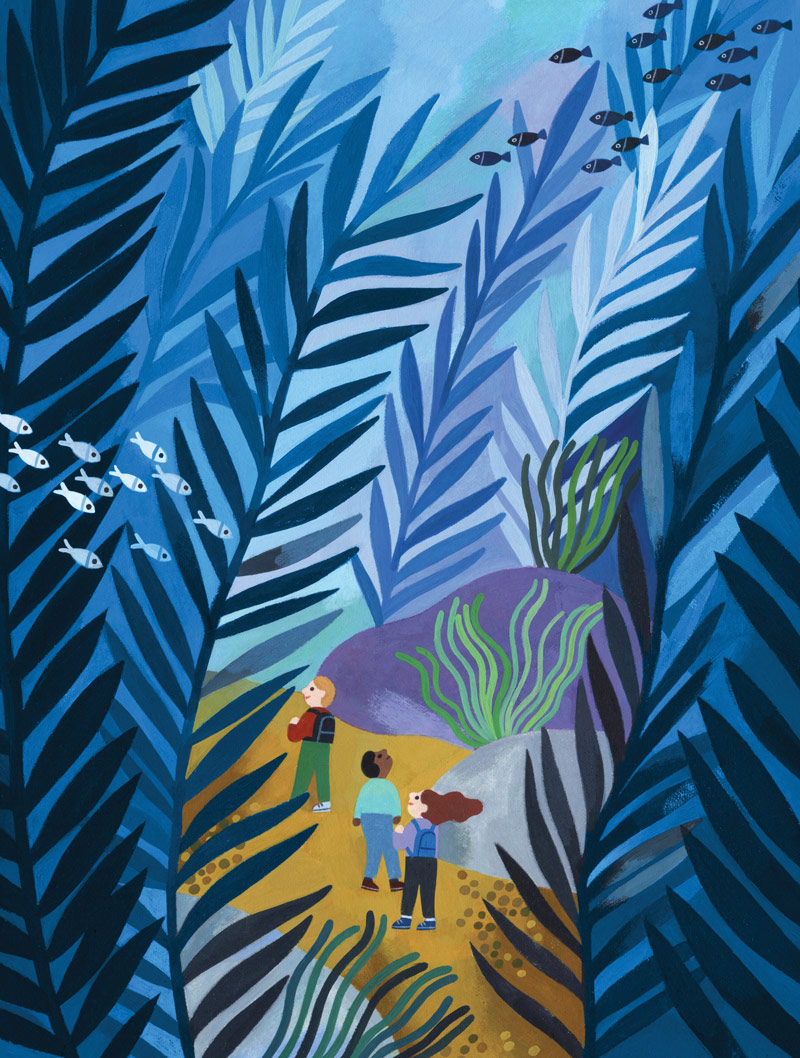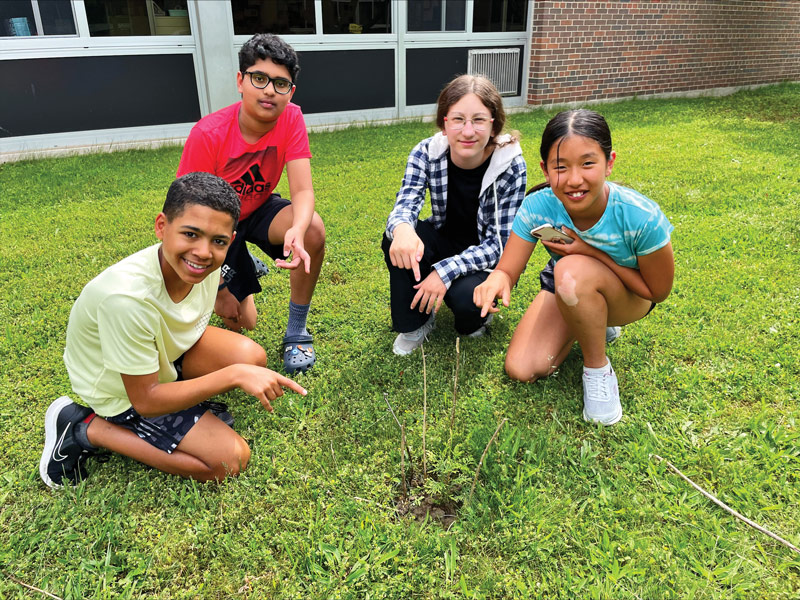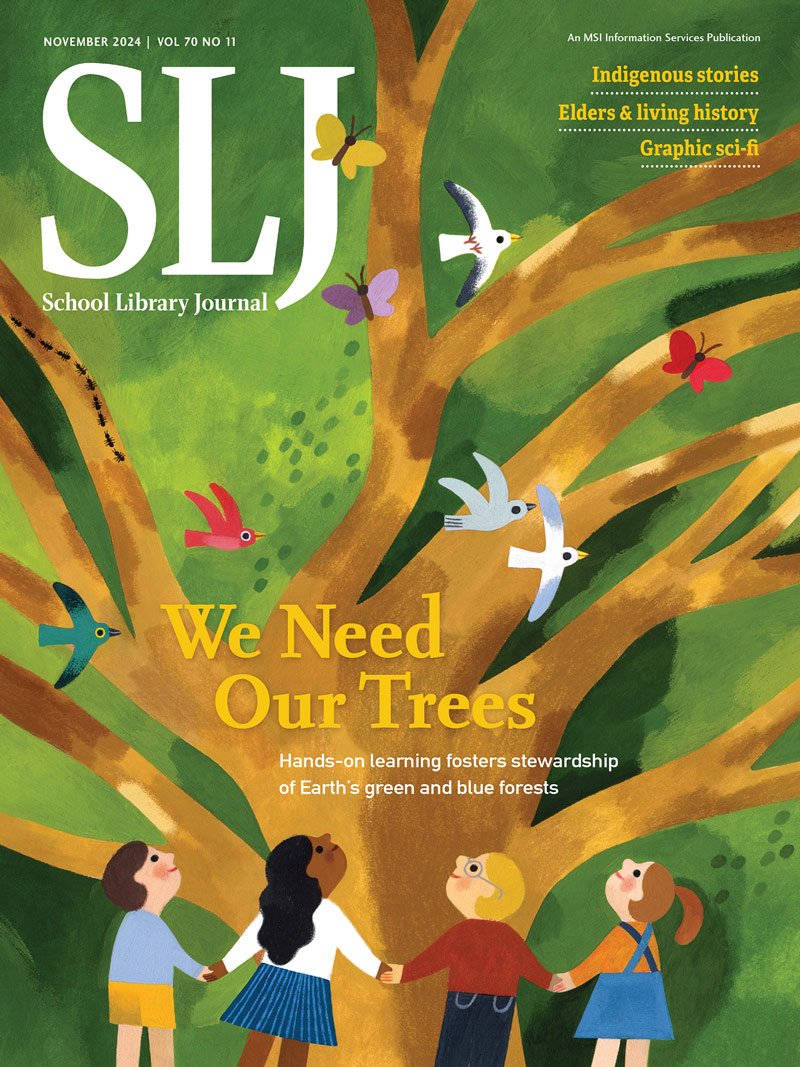Save Our Trees: Fostering Hands-On Stewardship of Earth’s Green and Blue Forests
Help kids understand the vital role forests play in absorbing greenhouse gas emissions and how they can protect trees.
 |
Illustration and SLJ November Cover (below) by Beatrice Cerocchi |
Also read:"Earth's Blue and Green Forests: Learning Resources and Professional Development" |
Librarians across the map are finding ways to get kids out of the classroom and into nature to experience the benefits of outdoor learning. When students plant or preserve trees and forests on school grounds and in their communities, they promote environmental awareness and stewardship of trees firsthand. And when they see others caring for nature and understanding the vital function of trees in battling climate change, they are more likely to want to protect nature themselves and take action.
Jennifer Whipp, a Canadian librarian with an environmental science background, designed a “tree trek” for her community on a local hiking trail. “I hung signs identifying 15 different species of trees and plants along the path, with interesting facts and photos. Some of the schools use that trail recreationally and did the tree trek as a class.”
[Also read: "Eco-Action: Turning Students’ Climate Anxiety into Agency"]
A student-made tree trek is just one example of how young activists can share facts about the benefits of trees, their role in climate resilience, and their influence on community health. Many other student activities, both outdoors and in the classroom, can raise awareness about the extraordinary value of mature trees, which can sequester up to 48 pounds of carbon-based greenhouse gas each year. Trees also benefit the environment by lowering temperatures, improving air quality, changing air currents, filtering water, managing storm runoff, providing much-needed habitats for insects and wildlife, and improving the physical and mental health of community members.
 |
Students from Barker Road Middle School in Pittsford, NY, with a
|
At Benicia (CA) Middle School, library technician Alexis Harmor coordinated a tree-planting activity with her local school district through the Neighborhood Forest program, which provides students free saplings native to the area. “Many students feel overwhelmed by the larger global environmental challenges and may not know what they can do to positively change their environments,” says Harmor. “To the students directly involved, it gave them a hands-on, doable experience.”
Parents and students signed up through the school. Then, teachers arranged supplemental instruction and helped distribute black mission fig saplings to families to take home and plant. Many participating students take a picture by their sapling each year to chronicle their continued stewardship. In such a program, students can also begin to understand how native trees sustain local birds and other species, promoting biodiversity.
Native American perspectives should be included in environmental student programs. Tashia DeLaCruz-Arnold, education manager for the Quinault Indian Nation Education Department in Washington State, recommends the book Gifted Earth by Douglas Deur and the Knowledge-Holders of the Quinault Indian Nation (Oregon State University Pr., 2022) for use in after-school program design. The nonfiction guide to Pacific Northwest plants and trees compiles visual, oral, and written knowledge of the Quinault, who call themselves “the Canoe People—the people of the cedar tree.” Part of the tree curriculum has students outdoors identifying local trees and doing crayon rubbings of bark, needles, or leaves for a paper-bag nature journal. Kids read aloud stories from the book that describe authentic Native perspectives and traditional uses of trees they see on the walks.
[Also read: "Eco-Action: Turning Students’ Climate Anxiety into Agency"]
In addition to understanding how trees benefit our global ecosystem, students near coastal areas may encounter kelp washed up on beaches from the amazing blue forests—found in marine and coastal ecosystems—that contribute to the ocean’s climate resilience. Kelp is one of the fastest-growing plants on Earth, and kelp forests can absorb almost 20 times the carbon that trees do in the same amount of space. In a 12-week program for second through fifth graders, students in Maine learn how kelp contributes to water quality and absorbs carbon dioxide in the ocean. Using a curriculum that takes students out on boats and to the beach, and has them tasting kelp as a food source, the Kelp4Kids program nurtures early environmental science exploration and protection of blue forests.
As children grasp the critical importance of reducing greenhouse gas emissions and the vast amounts that forests absorb, they can show all people how to promote a better world—by saving the one we have. for more teaching ideas, browse this list of learning and professional development resources.
Tiffany Coulson is a curriculum designer and research librarian for Altera, an educational nonprofit.

RELATED
The job outlook in 2030: Librarians will be in demand
The job outlook in 2030: Librarians will be in demand
ALREADY A SUBSCRIBER? LOG IN
We are currently offering this content for free. Sign up now to activate your personal profile, where you can save articles for future viewing






Add Comment :-
Be the first reader to comment.
Comment Policy:
Comment should not be empty !!!